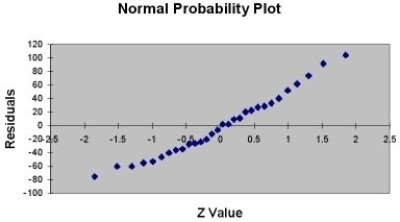TABLE 13- 11
A company that has the distribution rights to home video sales of previously released movies would like to use the box office gross (in millions of dollars) to estimate the number of units (in thousands of units) that it can expect to sell. Following is the output from a simple linear regression along with the residual plot and normal probability plot obtained from a data set of 30 different movie titles:
ANOVA


-Referring to Table 13-11, what are, respectively, the lower and upper limits of the 95% confidence interval estimate for population slope?
Correct Answer:
Verified
Q36: TABLE 13-3
The director of cooperative education at
Q52: TABLE 13-4
The managers of a brokerage firm
Q67: TABLE 13-4
The managers of a brokerage firm
Q70: TABLE 13-5
The managing partner of an advertising
Q78: TABLE 13-5
The managing partner of an advertising
Q113:
Q114: TABLE 13- 11
A company that has
Q118: TABLE 13-4
The managers of
Q149: TABLE 13-10
The management of a chain electronic
Q181: TABLE 13-12
The manager of the purchasing department
Unlock this Answer For Free Now!
View this answer and more for free by performing one of the following actions

Scan the QR code to install the App and get 2 free unlocks

Unlock quizzes for free by uploading documents